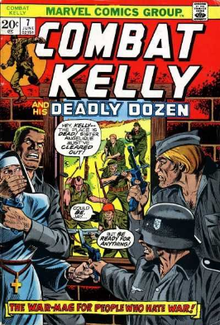
Sgt. Fury and his Howling Commandos is a comic book series created by Jack Kirby and Stan Lee and published by Marvel Comics from 1963 to 1981. The main character, Sgt. Nick Fury, later became the leader of Marvel's super-spy agency, S.H.I.E.L.D. The title also featured the Howling Commandos, a fictional World War II unit that first appeared in Sgt. Fury and his Howling Commandos #1.

Archie Goodwin was an American comic book writer, editor, and artist. He worked on a number of comic strips in addition to comic books, and is known for his Warren and Marvel Comics work. For Warren he was chief writer and editor of landmark horror anthology titles Creepy and Eerie between 1964 and 1967. At Marvel, he served as the company's editor-in-chief from 1976 to the end of 1977. In the 1980s, he edited the publisher's anthology magazine Epic Illustrated and its Epic Comics imprint. He is also known for his work on Star Wars in both comic books and newspaper strips. He is regularly cited as the "best-loved comic book editor, ever."
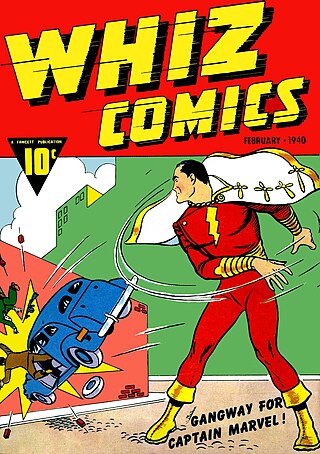
Whiz Comics was an anthology comic book series published by former American comic book publishing company, Fawcett Publications between February 1940 until June 1953. It is widely known for being the comic run in which hugely popular superhero character Captain Marvel (Shazam) made his debut.

Gary Friedrich was an American comic book writer best known for his Silver Age stories for Marvel Comics' Sgt. Fury and his Howling Commandos and in the following era, the series The Monster of Frankenstein, as well as for cocreating the supernatural motorcyclist Ghost Rider and the supernatural hero the Son of Satan.
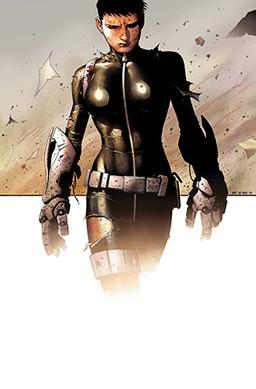
Daisy Johnson, also known as Quake, is a fictional superhero appearing in American comic books published by Marvel Comics. Created by writer Brian Michael Bendis and artist Gabriele Dell'Otto, the character first appeared in Secret War #2. The daughter of the supervillain Mister Hyde, she is a secret agent of the intelligence organization S.H.I.E.L.D. with the power to manipulate vibrations.
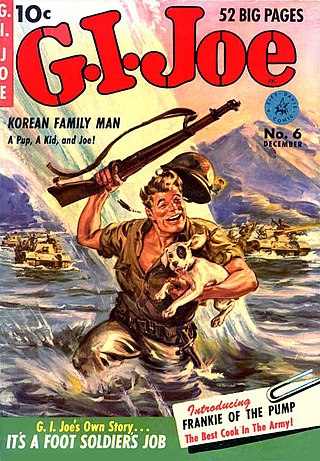
War comics is a genre of comic books that gained popularity in English-speaking countries following World War II.

Percival "Pinky" Pinkerton is a fictional character appearing in American comic books published by Marvel Comics. The character's first appearance was in Sgt. Fury and his Howling Commandos #8, in which he replaced Jonathan Junior Juniper who was killed in issue #4. He was created by writer Stan Lee and artist Jack Kirby.
General Samuel "Happy Sam" Sawyer is a character that appears in American comic books published by Marvel Comics. His first appearance was in Sgt. Fury and his Howling Commandos #1.

Miss Fury is a fictional superheroine from the Golden Age of Comics. She first appeared as The Black Fury on April 6, 1941, a Sunday comic strip distributed by the Bell Syndicate, and created by artist June Tarpé Mills. The strip was retitled Miss Fury in November 1941.

Captain Savage and his Leatherneck Raiders is a World War II comic book published by Marvel Comics. The series lasted for nineteen issues, from January 1968 to March 1970. By issue #9 the name was switched to Captain Savage and his Battlefield Raiders. Created by Gary Friedrich and Dick Ayers, the book was a spin-off of the series Sgt. Fury and his Howling Commandos which they wrote at the time. The series was launched when Marvel suddenly received the ability to publish more titles than they had previously due to an embargo.
Combat Kelly is the name of two fictional characters appearing in American comic books published by Marvel Comics. Both appear in war comics titles: Combat Kelly, published by Marvel's 1950s iteration, Atlas Comics, and set during the Korean War; and the 1970s series Combat Kelly and the Deadly Dozen, set earlier during World War II.

Nicholas Joseph "Nick" Fury Jr. is a fictional comic book character appearing in books published by Marvel Comics. He is a son and successor of former U.S. Army hero/super-spy and the intelligence agency S.H.I.E.L.D. director Nick Fury. The character first appeared in Battle Scars #1, which was written by Matt Fraction, Chris Yost, and Cullen Bunn, and penciled by Scot Eaton.

Marvel Now! is a comic book branding for the relaunch of several ongoing comic books published by Marvel Comics, that debuted in October 2012 with new #1 issues. The relaunch also included some new titles, including Uncanny Avengers and All-New X-Men. Described as a shifting of the Marvel Universe following the conclusion of the "Avengers vs. X-Men" storyline, Marvel Now! entailed changes to both the publishing format and the universe to attract new readers. Publishing changes included new creative teams for each of the titles and the in-universe changes included changes to character designs and new storylines. It marked the next stage of the Marvel ReEvolution initiative, which began in March 2012. The original run went through several waves before coming to an end in May 2015 at the start of the "Secret Wars" storyline. A second Marvel Now!, Marvel Now! 2.0, debuted in 2016 following the "Civil War II" storyline. Marvel Now! 2.0 was followed in 2017 by Marvel Legacy.

The Marvel Cinematic Universe tie-in comic books are limited series or one-shot comics published by Marvel Comics that tie into the films and television series of the Marvel Cinematic Universe (MCU). The comics are written and illustrated by a variety of individuals, and each one consists of 1 to 4 issues. They are intended to tell additional stories about existing characters, or to make connections between MCU projects, without necessarily expanding the universe or introducing new concepts or characters.

Fury of S.H.I.E.L.D. is a comic book miniseries written by Howard Chaykin and drawn by Corky C. Lehmkuhl. Published by Marvel Comics in 1995.

Fury: My War Gone By, also known as Fury MAX or Fury MAX: Cold Warrior is a 2012-2013 thirteen issue comic book limited series written by Garth Ennis and published by Marvel Comics. The series follow the character of Nick Fury during his military career under the course of the 20th century after the Second World War, when Fury participated in most of the United States' Cold War initiatives around the globe. Like most of Ennis's previous works on characters that are mainly figures in the world of superheroes so does the series do away with those elements, it instead fixate on the real life dealings of soldiers and spies in historical situations. It is a sequel to the 2001 series Fury and the 2006 series Fury: Peacemaker, both also written by Garth Ennis. The comic was drawn by Goran Parlov who had previously worked with Ennis on his Punisher series. The series garnered decent sales and critical acclaim.

Sgt. Fury & his Howling Commandos: Shotgun Opera also known as simply Shotgun Opera or Sgt. Fury and his Howling Commandos, Vol. 2 is a 2009 comic book one-shot published by Marvel Comics. The story was written by Jesse Alexander and drawn by John Paul Leon.

"Nick Fury, Agent of S.H.I.E.L.D." was a feature in the comics anthology Strange Tales which began in 1965 and lasted until 1968. It introduced the fictional spy agency S.H.I.E.L.D. into the Marvel Comics world and reintroduced the character of Nick Fury as an older character from his concurrently-running series Sgt. Fury and his Howling Commandos, which was a series set during World War II. The feature replaced the previously running Human Torch feature in the book and ran alongside the Doctor Strange feature. After the feature ended, a comic book series was published which has had several volumes as well as a comic strip. The feature was originally created by the duo of Stan Lee and Jack Kirby who also created the original Sgt. Fury series but it was later taken over by artist and writer Jim Steranko. The feature was often censored by the Comics Code Authority due to Jim Steranko's provocative art; this art helped change the landscape of comics which Steranko continued with in the 1968 ongoing series. Much of Nick Fury's supporting cast originated in the feature and many of the devices used by these characters were often used in other comics published by Marvel.
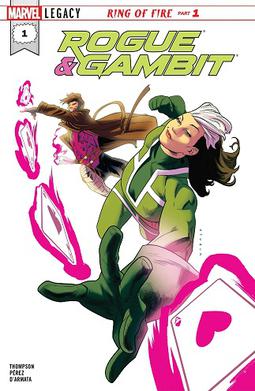
Rogue & Gambit is a five-issue comic book limited series published by Marvel Comics between January and May 2018. Created by writer Kelly Thompson and artist Pere Perez, it starred the popular X-Men characters Rogue and Gambit who reignite their relationship while investigating the disappearance of mutants at a vacation resort. The series received generally positive reviews from comic critics.
